
Reading Time: 9 minutes
As winter approaches, temperatures are dropping and days are getting shorter and that means it’s time to winterize your boat. Sadly for most boating enthusiasts this means the end of fun for a while. But, as any boater worth his salt will tell you, that before you can put your vessel into hibernation, there is a bit of work to do.
This post opens the hatches to information on how to winterize your boat thoroughly—and we also have a look at how Nationwide Auto Transportation can ship your watercraft to your favorite body of water.

Reasons to Winterize Your Boat | Is Your Boat Ready for Winter?
Your breath forms little fluffy clouds and the bass are starting to change their pattern. Two definitive signs that it is time for boat people in our states up north, to shed a collective tear, and start thinking of getting their babies into storage.
If you enjoy to boat in places like Kalamazoo, Milwaukee, Chicago, or Rochester—icy places where the weather can create ice of two feet and more—you will know that winterizing your boat is essential and failing to protect motors, water systems, air conditioners, and other items from cold damage could be extremely costly.
But if Floridians, Texans, Georgians, our boating brothers from the Bayou State and even sundrenched Californians think that they are getting a free pass, they’re gonna be a bit disappointed. Did you know that according to marine insurers these so-called, ‘temperate states’ prompt the largest number of claims for freeze damage in the U.S?
Winterize Your Boat | Save $$$
And why is this, you may ask? Some boat owners gamble that they can sail past a few cold spells—and when the (d)ice rolls against them, it can cost them more than a few dollars. Those of you who keep your boat in areas that aren’t normally subject to freezing weather, and would like some suggestions to help you protect your vessel against freeze damage like a cracked engine block, but still go boating again when spring comes back, just carry on reading.
It doesn’t matter where you keep your boat—in the polar north or in a more temperate climate—we will help you prepare for the winter and have a trouble-free and smile-filled launch in spring.
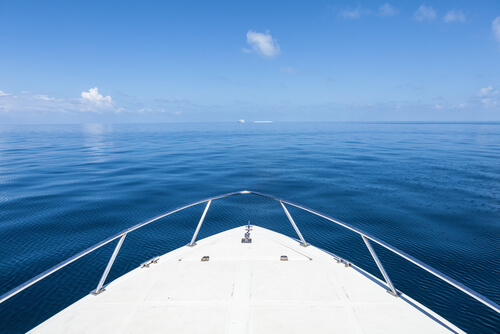
Winterizing Your Boat—It’s a Hull of a Story
Winterizing your boat is not something to be sneezed at. You can’t just slosh in some stabilizing fluid in fuel, drain the engine, and add a dash of antifreeze… and then sit back and open a beer. No, siree; basically, it involves a methodical procedure that runs from bow to transom. Since engines and boats differ by make and model, start by checking the winterizing and storage sections of your owner’s manual.
Your fiberglass hull is on the water 24/7 and takes a pounding from the scorching summer sun and waves of salt water crash against it constantly, so why would a bit of cold and snow be something to worry about? If ice builds up enough, window tracks and hatches can crack or split open, resulting in leaks. If your boat is going to be outdoors, a suitable boat cover is a must.
Hull Inspection
This is the time to inspect the hull thoroughly and look for any damage, blisters or stress cracks. That’s a key part to the process when you winterize your boat.
The presence of cracks could be a sign of structural damage, and going unnoticed could be disastrous. Call in the help of a professional.
Unwelcome passengers like barnacles, that cling for a free ride to the bottom of your hull, can be kicked off the bus by scraping, and then sanding any residue. The best way to remove dirt and sea scum from your hull is with a good pressure wash. You’ll make this job a lot easier in the future by using one of several good marine cleaning products on the market.
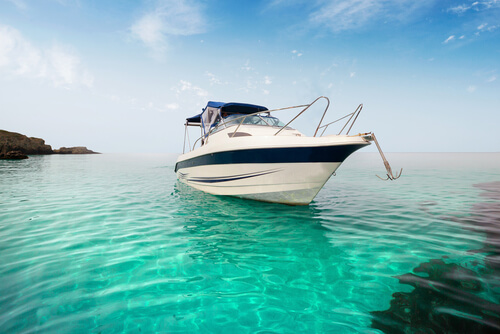
The Inside Story
Vinyl interiors are not friends with winter air; humid or dry, both can cause damage. To stop drying out and cracks, there are many sprays and gels that clean and protect your vinyl.
Moisture that leads to mildew is even more dangerous. Imagine unzipping your Sea Senor come springtime, and to be greeted by a science experiment from the Blue Cheese Planet. Mildew and mold can ruin a summer vacay instantly. The solution is to ensure good airflow in your boat cover to prevent moisture accumulation. In addition to mildew sprays, chemical dehumidifiers are very helpful for manhandling moisture away from the air.
What happens when water and electricity decide to have a bit of a get together? Sparks fly, I tell you, and not in a good way either. Moisture causes corrosion—and you have electronics on-board, linked to an electrical system… and moisture likes doing the nasty here.
Keep it Dry
Your wiring, especially if it isn’t marine-grade, is prone to corrosion, which can lead to shorts, blown fuses, and even a LARGE overhaul bill. Take your electronics to hibernate in a friendlier environment, then, spray the exposed electrical connections with an evaporative lubricant. This is now where you need to haul out the elbow grease and start shining the brightwork and vacuum and wash carpets and deck.
Get your coveralls on and start busting—when you winterize your boat—grime, not ghosts that is. Clean and dry the removable head if you have one—for non-boaters, we are talking toilets here—on your boat before storing it. It’s a good idea to drain and refill built-in units with antifreeze, including sinks and showers.
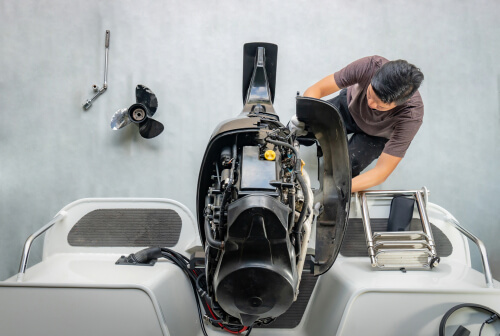
It Must Be a Cover Up
Choose a boat cover that protects the waterline as part of your boat winterization process. Polytarp covers are relatively cheap, but, just like any other covering, they must be supported by a frame to evenly disperse the weight of the snow away from weak points of the boat.
If you don’t want to use wooden planks along the ridge of your frame, you can strap it. Stretchable strapping makes a smooth arch that shapes shrink wrap nicely. This helps with even dispersal of rain and snow. Use two layers in areas with heavy snowfalls for more support. Screws are easy when dismantling the frame for re-use.
A polyvinyl cover is commonly used for its water resistance and immunity to mildew and stains. Tie the cover down or tape it in place so the wind does not get underneath, blowing in snow or damaging the cover. When used properly, shrink wrap will protect your boat from heavy snows as well as falling objects that might dislodge a tarp.
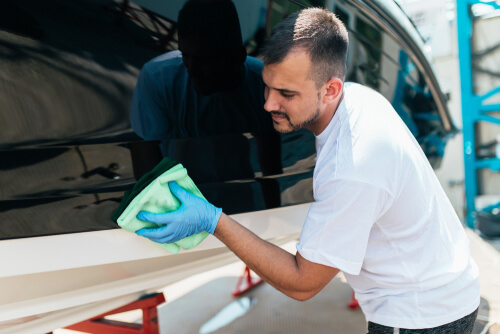
Motor Lives Matter, Winterize Your Boat
Your engine is the heart and power of your boat and should be looked after as such. You try to take care of your heart, cause it keeps you alive. Do the same for your motor and it will live a long and purring life. Freezing, corrosion, and fuel degradation are winter’s biggest engine hazards. So what to do?
- Remove the engine cover and check for any frayed or loose wires, links and clamps.
- All hoses should be examined for softness and cracks and replaced if necessary.
- The belts should be checked for wear and tension should be adjusted if necessary.
- Prevent corrosion by touching up any paint nicks.
- Make sure you change the oil and filter after the engine reaches temperature.
- Using fresh water, flush the engine. Some outboard motors come with hose attachments to make the task easier. There are ways to backup flush sterndrive and outboard engines. Let the engine idle, taking care to watch the temp gauge, until clean water flushes out. Using a piece of wire, clean all outboard telltales, and store the engine vertically in a dry place to allow as much water to drain as possible. It just takes a little water left in the engine to freeze and cause a lot of damage. Propylene glycol antifreeze should always be added to inboard and sterndrives in order to prevent ice pockets from forming and cracking the block.
- Fuel evaporates in storage and forms a varnish which sticks to injectors and clogs jets. In just two weeks, the degrading action can begin, leading to a reduction in the fuel’s octane rating. After you add fuel stabilizer to the tank, idle the engine for 10 to 20 minutes to spread it throughout.
Do Not Rush Winterizing Your Boat
- The best way to prevent rust and corrosion of engine internals is to remove the engine flame arrestor and spray fogging oil through the carburetor while the engine is running.
- To burn up remaining fuel in the carburetor/fuel-injection system, close the fuel valve or pinch off the fuel line. Pull the plugs and spritz the cylinders with fogging oil afterwards. Rotate the engine several times for a good oil coating, then reinstall the plugs.
- As you move to the stern, wedge a block of wood between the propeller and anti-ventilation plate, and loosen the prop nut. Examine the propeller, hub, and splines for damage. A water pump impeller change is a cheap way to prevent a failure next spring.
- Make sure the gear case lube isn’t milky in color. This would indicate that there is water in the oil. Look for metal chips, which indicate that the gears are grinding more than the horsepower is.
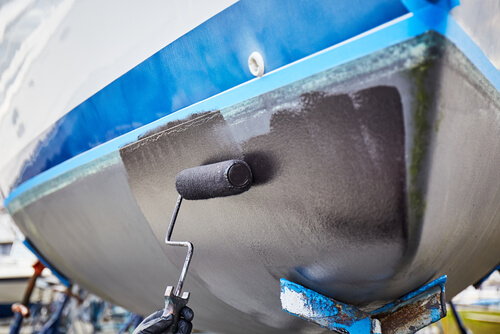
Your reward will be a quick launch in spring if you do winter maintenance diligently. But beware if you don’t winterize your boat properly. Repairs in spring is paramount to fun-suicide – this is the busiest time for boat mechanics and you will be spending more time out of the water, than on it (except when you need to go to the bank to find money to pay your technician, who charges you according to the season, and it is not cheap).
If your favorite repair shop happens to be a few states away, Nationwide Auto Transportation can save you the stressful drive. Once you have decided to ship your vessel, these 6 Top Tips From the Pros on Boat Transport will help put you in the know.
Nationwide Auto Transportation for Boat Shipping
At Nationwide Auto Transportation we understand that everyone is busy and our brains really struggle to remember anything, unless there is an app or something to remind us. We have built you this app, called a checklist to make it easier for you to winterize your boat. See below. By reading it and keeping it, you will remember exactly what to do.
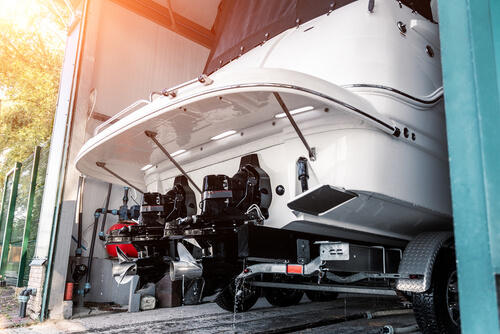
Engine Winterizing Checklist (for Outboards, Inboards, and Sterndrives)
- Remember the fuel stabilizer
- Plugs, wires, rotor and cap should all be checked
- Belts need inspection, adjust tension
- Check all the hoses
- Replace the fuel filter and clean the fuel screens
- Check the gear and throttle settings and cables
- Lubricate the cables, connectors, and links for the throttle and shift
- Flush the cooling system
- Drain the circulating pump, block, manifold, and coolers
- Fill them with antifreeze
- Change gear lubrication fluid
- Oil and oil filter should be changed
- Check gimbal bearing
- Lubricate U-joints and gimbals
- Lubricate engine coupler splines
- Check/replace sacrificial anodes
- Fog the engine
- Fluid level should be checked for steering and power trims
- Touch up scratches and nicks
- Be sure to check the propeller/hub
- Check and lubricate the splines
- Water pump impeller needs to be replaced
- Protect electrical connections from moisture by spraying them with a moisture repellent
- An anti corrosion treatment should be applied to the entire engine
- Be sure to check the fuel line and the bulb
- Battery should be removed and recharged if necessary
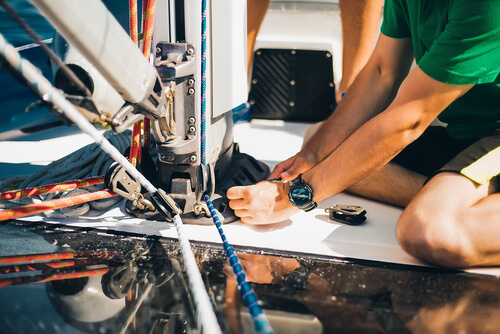
To Summerize How to Winterize Your Boat
The process of getting a boat back in service after a seasonal break (summerize your boat) is much easier when certain things are done beforehand. If you live up North, you winterize your boat and engine before storing them for the winter. Down South, they summerize their watercraft before hitting the waves.
Boats are made summer ready because of tourists and seasonal crowds. Florida and other coastal areas are popular places for vacation homes and get-aways.
Their boat is available while they are there, and then they can summerize it before heading home, which is somewhere to the North, where it is now becoming warmer again. Once fall and winter return, they can get the boat back out and head back to the water.
Snowbirds, as these sun followers are known, have discovered some super sunny destinations. Read our blog on Snowbird Destinations: What are the best places to spend winter… and why?
Oh Ship, Your Boat Needs to be Somewhere
Driving long distances can be a real schlep, and if you are also towing a boat, then it is double as schleppy! In my humble opinion, only professional drivers or carriers should tow a boat for long distances. If you take into account the extravagant fuel costs, and now factor in risks like drunk drivers and high winds, it starts to sound a lot like an early Tom Cruise movie that involves business and risk.
Besides, if you let us ship it, you can fly there the day of your vacation and it’s all ready and done. You don’t have to drive and tow a boat for 3 days to get to your vacay spot on the other side of the country.
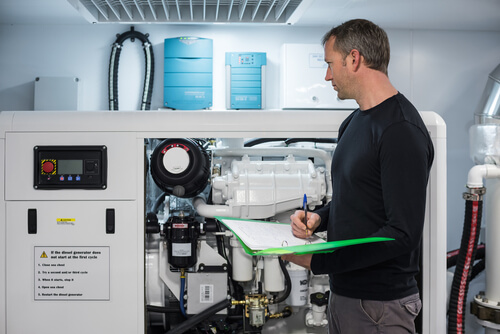
Do you need to ship your boat from New York to Florida, or practically anywhere else? Nationwide Auto Transportation offers yacht and boat transportation across the country. You can get more information by reading our post on Boat Shipping within the U.S. and for a no obligation quote, click right here!



